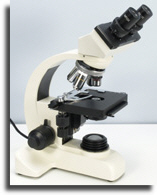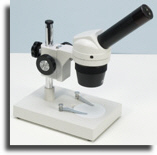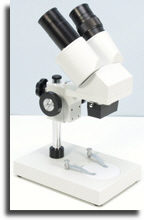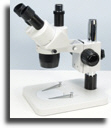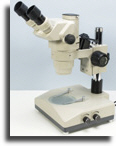Microscopes
by Mol Smith
2007
| This article is about optical microscopes. It covers
how to select a microscope for your use or as a gift for someone else and gives information about choosing a microscope
and where best to buy one. Many pages already exist on the web about buying and using microscopes but I have created
this page to simplify what often seems complex to somebody new to the study of the small world through a microscope. Plastic or Metal Only die-cast metal body microscopes have the stability required to offer shake-free viewing. Plastic bodied microscopes are inferior in the fact they are lighter (and therefore less stable) and likely to be damaged easily. An exception to this might be only when a field microscope requiring light-weight portability is required. Optical Microscopes Optical Microscopes are used for first-hand viewing of a range of extremely small subjects. Microscopes also exist which are not optical: scanning electron microscopes, tunneling microscopes, to name but two. We are only concerned here with optical microscopes! Microscope Magnification An optical microscope may have plastic or glass lenses. In its simplest form, it is a tube with one lens at one end (the eyepiece), and another lens at the other end (objective). The combination of these two lenses forms the magnification power of the microscope. So if the tube has a 5x eyepiece and a 20x objective, you will be able to observe microscopical sized objects and creatures at 100x magnification. Optical Microscope Limit Optical Microscopes use natural light by way of reflected light from a mirror, or artificial light by way of a light bulb or light emitting diode to illuminate the subject being viewed. This creates a limitation in the ability of a microscope to magnify beyond a certain limit. With very well made glass lenses, the effective magnification range of all optical microscopes is approximately 1400x - 1600x. Effectiveness is about resolving detail in the subject observed with a microscope and not just about making something appear larger. Glass versus Plastic Lenses Many toy microscopes have plastic lenses. Plastic does not have the same light bending properties of glass and is greatly inferior as a substance to make lenses from. Only microscopes with genuine glass lenses should be used for all forms of microscopy from child to adult, and from amateur to professional. Children are often bought microscopes with plastic lenses and because their first view of the microscopical world is blurred and hazy, they fail to be inspired. Compound Monocular, Binocular, Trinocular, and Stereo Microscopes These are the four basic forms of optical. All these microscopes, with the exception of the stereo microscope, are used to study subjects professionally prepared on glass specimen slides. Only the stereo microscope can be effectively used to study things without them having to be specially prepared first! Monocular A single tube with interchangeable eyepieces one end, and 1 or more objective lens (often on a revolving turret) the other end. Objects viewed through a monocular microscope will always look flat and without depth. Monocular microscopes are used to study true microscopic sized animals, plants and cells. Magnification ranges typically from 40x to 1400x with most useful observations being carried out in the 100x to 400x range. Monocular Microscopes are not recommended for very young children as they tend to produce a perspective which requires a slight degree of interpretation which young people may find difficult. Whole live insects are not observable with compound monocular microscopes. Binocular Virtually the same as a monocular microscope but with two eyepieces allowing less eyestrain. However, both eyepieces are trained onto a single objective lens so all views are flat. More expensive than a monocular microscope without much increase in potential. Trinocular Virtually the same as a binocular microscope but with a third eyepiece tube. No - not for people with 3 eyes, but for people who wish to attach a camera to the third eyepiece and be able to photograph or video what they can see through the two eyepieces. So, only consider a trinocular microscope if photography is a critical desire to do. Stereo Microscopes Low power stereo microscopes are perhaps the most useful optical microscopes for beginners with a wide range of applications and brilliant 3D viewing capability. I would recommend a stereo microscope for first time users, students, children, and everyone who will not be studying cells, or subjects at magnifications higher than 50x. A stereo microscope has 2 tubes - each with its own eyepiece and objective lens. Everything looked at is in real 3D and this greatly increases one's understanding of anything observed. From live whole insects right through to most of the microscopical animals and plants of pond, river, and oceanic life, the stereo microscope is the most useful instrument. Zoom Stereo Microscopes There are stereo microscopes with the functionality to smoothly zoom in and increase magnification whilst remaining focused on the specimen. They are typically 2x or 3x more expensive than non-zooming one but are exceptional instruments for anyone serious about microscopical study. Young children should always be given a stereo microscope first! They will be inspired by what they see. Note that the very young may have trouble with the eyepiece spacing of a stereo model designed for an adult, but a simple monocular low power microscopes are available and widely used in primary schools (these are sometimes called dissecting microscopes). The types of Optical Microscopes are shown below (Courtesy of Brunel Microscopes)
Optical Microscopes Extras I have defined the four types in their basic form but of course these instruments can be purchased with a range of extras to help effective use. Here are some of the things to look out for. Illumination The way a specimen or subject is lit under a microscope is absolutely critical. The more advanced the illumination system, the better chance there is of observing greater detail in the thing being studied. An illumination system can come in the form of a tiny mirror angled just below the specimen slide stage to reflect natural or ambient light (the most basic and cheapest system) or a proper system comprising light source, condensing lens, and aperture, to give fine control and focusing of light onto the specimen. More advanced illumination systems are obtainable providing specialist features. Light sources can be either a filament bulb (which also produces a lot of heat) or as a light emitting diode (non-heat). Microscope Focusing The microscope is focused onto the specimen. This involves shifting the distance between the objective lens and the specimen. On all non-stereo microscopes, the objective lens is only a very tiny distance away from the specimen slide. A very accurate and steady focusing system is desirable. Most systems are comprised of a toothed rack which the tube slides up and down on in tiny amounts according to the turn of a thumb-wheel (rack and pinion). Second hand microscopes may often have much wear in this system causing the tube to slowly slip further down from where the user sets it. Certain types of grease may be carefully applied to create more friction and prevent slipping in these circumstances. X-Y Stage When looking through a microscope at a very small object in a very small area, it is difficult to track a moving object. Typically, tiny creatures making up pond life dash around all over the place. If you intend to look at moving microscopical creatures for long study periods, you will certainly require a microscope with a moving stage. The stage forms an almost friction-free smooth platform which can be moved along two lines of axis (x and y) by gently turning two controls. This enables a specimen slide or Petri dish to be moved tiny fractions of distances and so allow a subject to be kept in the microscope's field of view. Specimen Slides Except for stereo microscopes, most other optical microscopes use specimen slides. These can be simple flat slivers or glass on which a specimen is placed and covered with an even thinner sliver of glass (cover slip) or they can be prepared slides. The latter are professionally made and often involves specialised treatment of the specimen before sealing them onto a glass slide. Boxes of prepared specimen slides can be purchased covering every aspect of biology, zoology, pond life, botany, etc., When purchasing an optical Microscope, always purchase some specimen slides to help get you started. Kits All manner of kits can be purchased to enable microscope users to make their own specimen slides. This itself can be a very interesting and worthwhile hobby. Typical Costs for a first-time Microscope A good budget non-zooming stereo microscope : £85.00 - £100.00 ($170.00 - $200.00) A good budget zooming stereo microscope : £400 - £600 ($800 - $1200) A budget monocular microscope - magnification 50x - 500x : £90.00 - £150.00 ($180.00 - $300.00) A budget binocular microscope & budget trinocular microscope : £250 - £400 ($500 - $800.00) High power Instruments with many extras - polariser, sophisticated Illumination systems, movable stages, many lenses, higher quality lenses : £500 - £1200 ($1000.00 - $2400.00) More expensive microscopes can cost many thousands of pounds but only organisations and companies performing very exacting research work are budgeted for this. Most people should not need to spend more than a few hundred pounds for a first class microscope effective in all the things they are likely to study. Need Help selecting a Microscope? I have arranged for anyone needing help with choosing a microscope to receive friendly free advice (without strings) from Brunel Microscopes in the UK. This is a long-standing microscope and accessories small family business, well known to existing UK microscopists from amateurs, through to enthusiasts and professionals. Call their HELPLINE here on: From UK: 01249 462655 International 0044 (0)1249 462655 Or visit their Web Site Here! |
Microscopy
UK Front Page
Micscape
Magazine
Article
Library
© Microscopy UK or their contributors.
Published in the May 2007 edition of Micscape.
Please report any Web problems or offer general comments to the Micscape Editor.
Micscape is the on-line monthly magazine of the Microscopy UK web
site at Microscopy-UK

